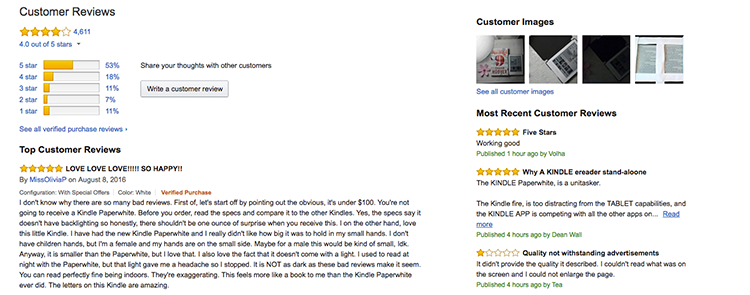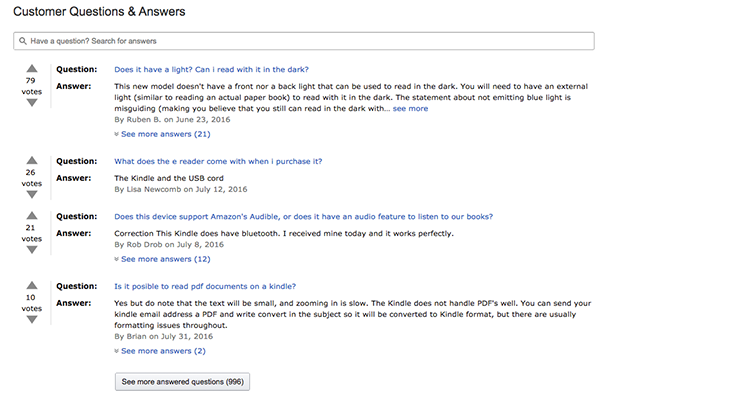Your eCommerce product page has to fulfill multiple roles at once: a world-class storefront, a knowledgable salesperson and an effective landing page. It is one of the first and last pages that a new customer will navigate to in your store, and in an environment where your customer can’t experience the physical product, the product page can have the biggest impact on sales conversions.
For each product, you have to be able to uniquely illustrate the benefits while also maintaining a consistency between other products and your store overall. Getting it all right can be tricky, but getting it wrong can be very costly. I have reviewed four common issues that eCommerce stores could improve on.
1. Social Proof
When a customer is unsure of an item or the situation is ambiguous, they rely on the recommendations of people who have been in their situation. As Changing Minds discusses there are two psychological types of influence that need to be understood; private acceptance is when we genuinely believe the information source is right, and public compliance is when we copy others because of fear of ridicule or rejection. As an eCommerce store you want to build both by:
A. Showcasing product reviews
Stamped.io’s research indicates that 77% of customers will read reviews before buying, and that it helps build repeat customers. Most stores will have some kind of review feature on their product page but it is important to make sure it is easy for them to write, edit and interact with reviews as well. Make sure review requests are sent when customers have had the chance to actually experience the product.
Apps like Yotpo make adding this functionality to your store relatively straight forward and help you collect and utilise customer reviews more effectively.

Source: Amazon
Rather than asking generic questions like “How was the wallet?”, ask specific, leading questions like “What were you able to fit in your wallet?” or “What would you recommend to other people looking at this wallet?”. It will encourage more meaningful reviews and people will appreciate being called on as an expert.
B. Filling in information gaps
Social proof doesn’t just have to take form in reviews from customers. People also respect a store answering commonly asked questions from their community. Samsung proved this in a study of their online TV catalog. They found products that had answers from Samsung for commonly asked questions had double the product views of other product questions. In addition, by answering these questions they were also naturally creating content that 91% of the time was not found anywhere else on their website.
But most importantly, they found that answers had a rippling effect where questions would spark more questions and future sales.
“..having these answers within the purchase path helps drive sales conversion, so just one answer from Samsung can help drive incremental sales beyond the one person who asked the question.”

Source: Amazon
2. Details for Effective SEO
Most stores play close attention to SEO across their website as a whole. But individual attention needs to be paid to product pages. Unfortunately, as SKU’s continue to grow product SEO becomes more and more generic.
For people who are searching for specific products, your product page will be perfectly suited to long-tail keywords and people searching for specific products.
To do this, make sure your product page has:
- A detailed, unique product description. Having no description basically excludes your product from being in the top 10 of search queries. Likewise, using the manufacturer’s description will mean your content won’t be unique which will negatively impact your search rankings. Consider using a NO INDEX meta tag for product pages that you don’t have unique content for yet.
- Product reviews. As well as social proof, having product reviews will add unique content to your product page that is updated regularly.
- H1 tags optimized for what customers are searching for. Look at what customers are searching for in search engines, as well as your internal search to determine what keywords are best suited to the product and whether it should be made more specific.
- Image tags. An often neglected channel for SEO are image tags. Make sure they describe the product specifically and every image has an alt and title tag. Alt tags help for SEO but also for accessibility.
3. Excellent product photography
Your product photography is going to be the centerpiece of your product page. Even in information-driven purchases, good product photography can help the customer visualize the product and give them confidence in their purchase. Taking the time to remove the background and make a few adjustments can have a real impact on conversions.

Make sure you are taking excellent product photography, but ensure you also understand the purpose behind different types of product photos. For example, editorial photos are emotionally driven and will be featured on the home page or in marketing materials higher up the conversion funnel. They showcase the product in an interesting way that sparks the customers’ imagination.
On the other hand, product photos are what you want to feature on the product page. They show details of the product and should be clear and high enough resolution that the user can make out the details of the product.

Source: The Iconic
Consider using multiple product angles to convey as much information as possible. Focus on the details of your product, especially in cases where the quality of your stitching or machining reinforce your value proposition. Really effective photography will elicit a tactile response that lets the user vividly picture what the product would feel like.

Source: The Iconic
Good product photography can help in more ways than just conversion as well. By using scaling shots and accurately representing the product size and features with photographs you will see a noticeable reduction in customer inquiries and returns.
Where product photography doesn’t do justice to the medium, consider adding in further resources like explainer videos or audio files. Modern Producers sells digital samples for music producers. The product photography helps convey the genre and style of sample and the information describes the content, but to really showcase the product they embed audio samples into their product pages using Soundcloud.
4. Email Capture Form
Too often have I stumbled upon a new eCommerce store, spent some time learning about their brand and product and decided that I do actually want to buy a subscription of cricket-based energy bars only to be faced with the virtual brick wall – “Sold Out”. For a store owner it means at the least a lost sale. If you’re lucky the customer might reach out to you to find out when they can order, but even this puts a strain on customer service resources.
When you are sold out, your product page should include a back in stock email capture form and if possible an availability date. A simple app like Now in Stock will let customers sign up to updates and allow you to send reminder emails when the product is available again. This simple addition serves two important purposes. For one, it lets you stay in touch with customers who would have otherwise become invisible and while not as good an indicator as an actual purchase, someone signing up to out of stock notifications can also become a valuable tool in determining demand for different products. More advanced apps like Back in Stock help you do this by showing when customers are requesting out of stock items and what kind of conversion rates you are getting from sending back in stock notifications.
There are things you can do right now to see improved conversions on your eCommerce product page. Start by making sure all of your product photos are of a professional quality, either manually or by using a tool like Pixc. Run an SEO tool to make sure all your images are optimized and make sure you have an email capture form for your out of stock products.








